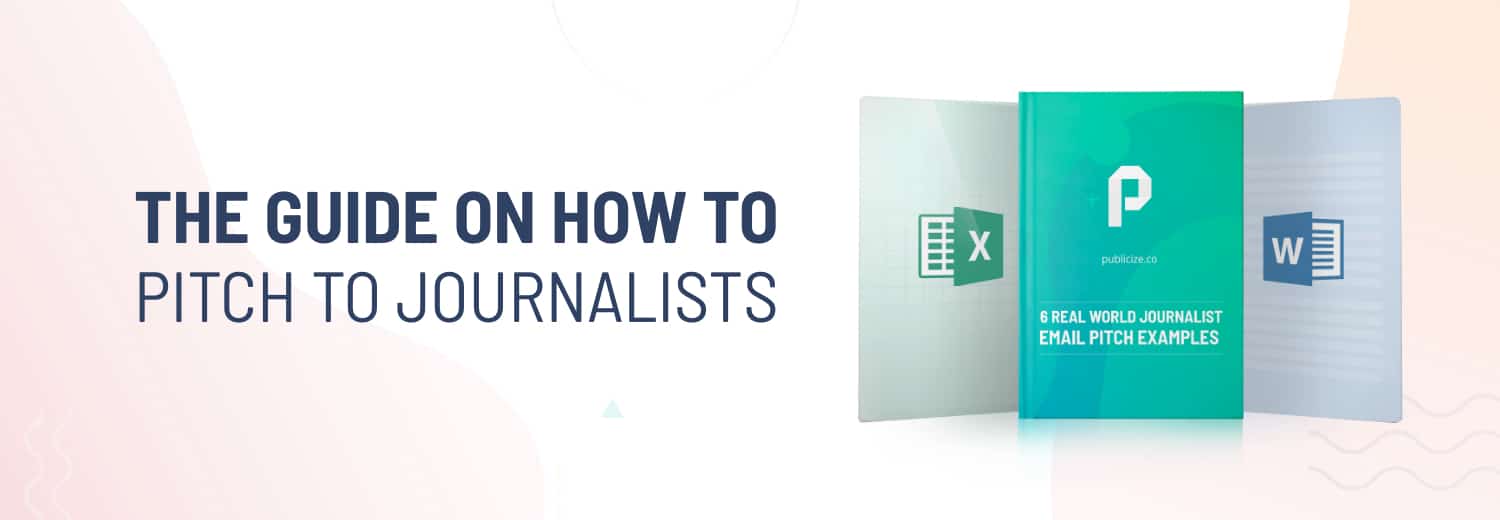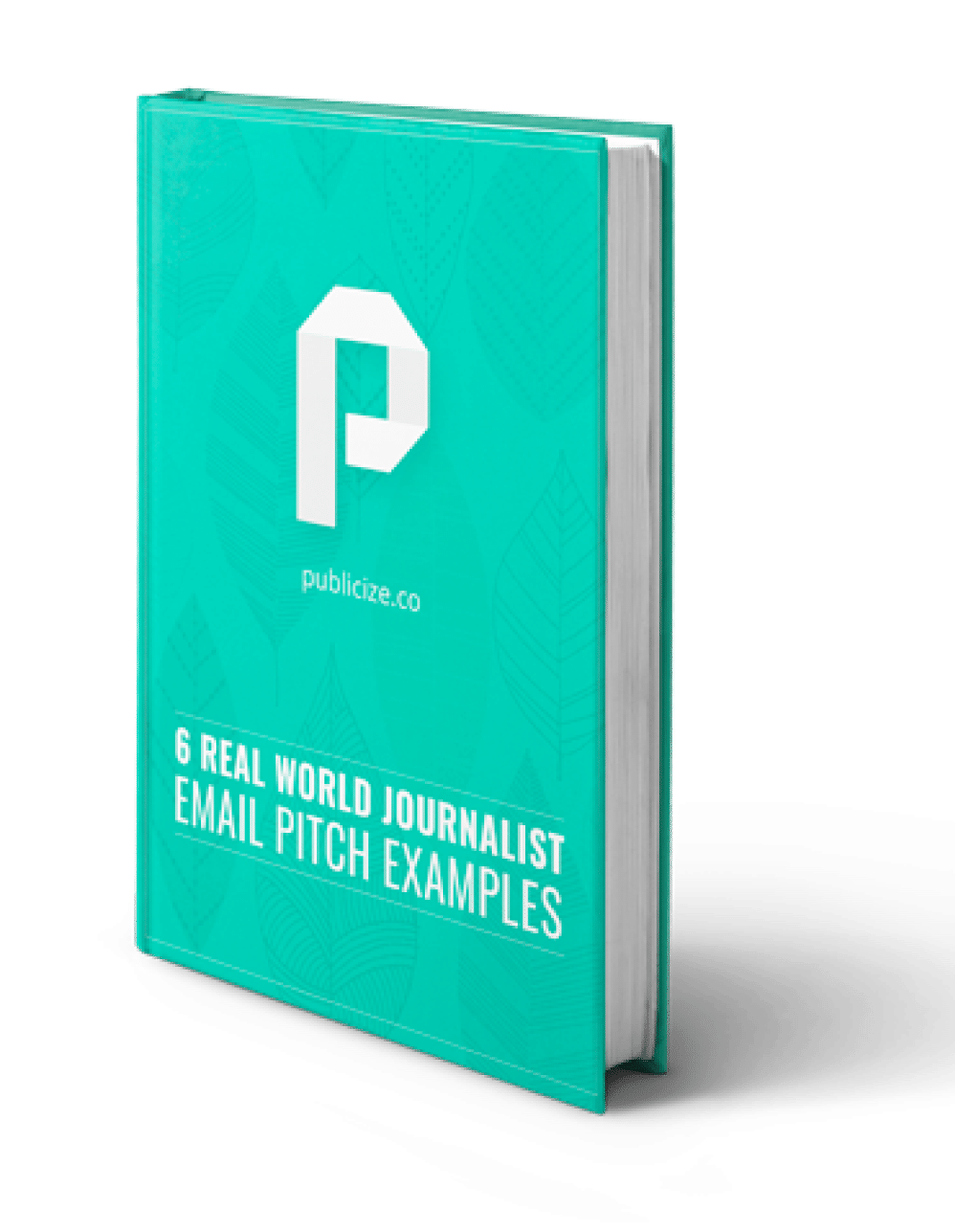If you want to listen to the audio version of THE GUIDE ON HOW TO PITCH TO JOURNALISTS, press play here.
If you want to win press coverage then you need to master two things: how to write an effective pitch and how to contact the media about a story in the correct way.
That’s why we’ve put together this how to pitch to journalists guide, to walk you through the following:
- How to come up with media pitch ideas
- The different types of media pitches and press coverage
- How to write a media pitch
- An email pitch to journalist example
- How to contact the press
And in addition to this guide, you can also download our Pitching to Journalists Toolkit, which contains 6 pitch email examples to journalists, as well as a sample media pitch email template.
Part 1 – How to come up with a media pitch
What is a media pitch?
Okay, I’m starting with the basics here! But it’s important for context. PR remains a bit of a mystery to many people and the question of how to get press coverage can be downright bewildering.
So here’s our media pitch definition:
A pitch is a speculative approach to a journalist, where you offer something of value, with the intention of it winning press coverage for you or your company.
What you offer to a journalist will determine the type of media pitch you send. I’ll walk you through this below.
How to come up with a killer pitch idea
One of the questions we get asked the most is how to get an article written about your company by a journalist.
It’s no use simply pitching any old thing to journalists. If a pitch offers no value, it’ll just end up in the trash folder. So how can you prevent this fate from befalling your media pitches? To get press coverage, also known as earned media, you need clearly defined business goals, a well-crafted narrative, and expert knowledge of your industry and current trends, as the below graphic demonstrates.
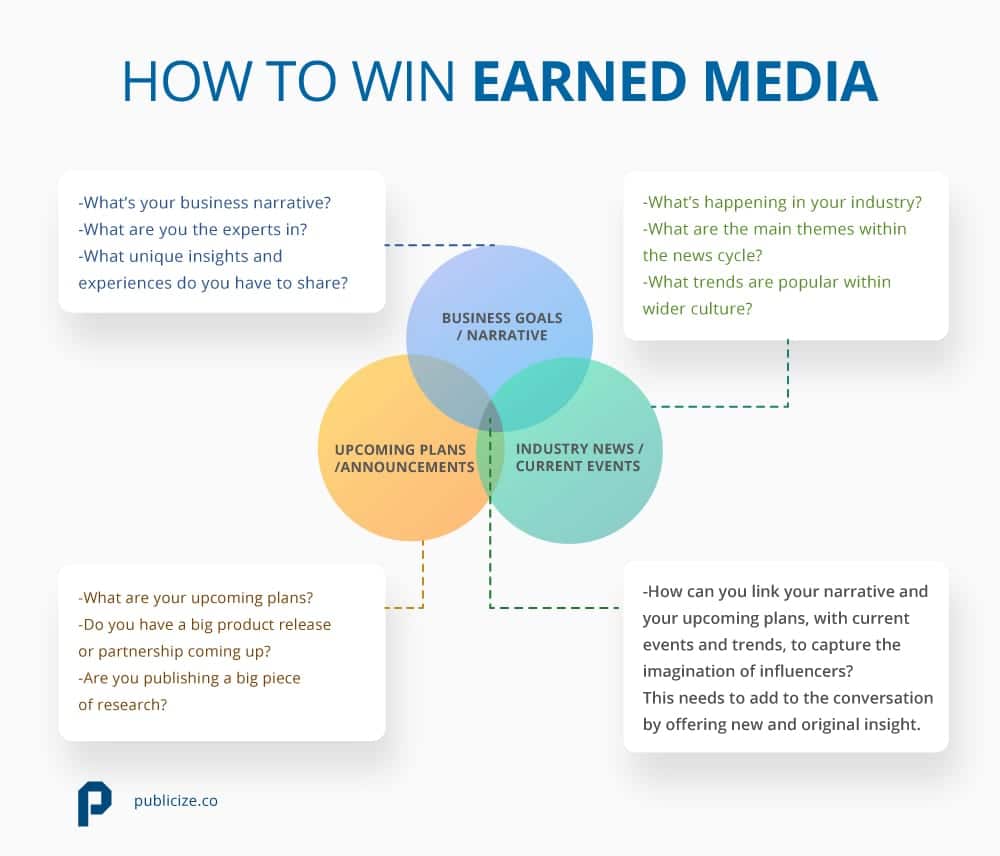
Ultimately – you need to give more than you take. What we mean by this is if you just pitch blatantly promotional stuff, such as why your startup is going to disrupt your industry, you’re not going to win press coverage.
Always bear in mind: it’s a journalist’s job to write stories, not promote products.
So with this being the case, you need to offer journalists news, stories or ideas that are unique and present real value to their readers.
Finding your hook
Every pitch needs a hook. This is the way you present your news, story or idea so that it stimulates interest and demonstrates its newsworthiness.
The hook you develop will depend on what it is you’re pitching and the industry you’re in. Here are some common examples to help you develop yours:
- Provide a fresh perspective: the media loves reporting on a trending topic, by providing a fresh perspective you’ll stand out by offering something new.
- Provide new insight: perhaps your user data has provided startling insight into an established topic.
- Tell the other side of a story: provide a counter-argument to the prevailing narrative on a popular topic, backed by data, results or experience.
- Challenge the orthodoxy: upend conventional wisdom or kill a sacred cow with your views and opinions.
- Break new ground: present data or research results on a niche area or subject matter that hasn’t been reported on before.
The following section helps to place all of the above into context, by providing media pitch examples we send to journalists.
The different types of PR pitches to journalists
We categorize our journalists’ pitches based on the type of story, news or insight they’re offering. Here’s the list of our most common press pitch types.
Guest article pitch*
Used when pitching for a guest post spot in a publication, which is talking about a general topic relevant to your industry.
Actionable insights pitch
Used when pitching actionable and practical insights which are based on your own experience and expertise.
Breaking news hook pitch
Used to jump on a breaking news story that’s relevant to you or your business by pitching to offer expert opinion and insight.
Sector overview pitch
Used when pitching to provide an overview or analysis of something that’s happening at a high level in your industry.
How X will help Y pitch
Used when pitching a story, advice or insight that provides a solution to a known problem.
Product review pitch
This one’s nice and simple. It’s used when you’re pitching your product to professional reviewers.
*When pitching for a guest article (otherwise known as a guest post), make sure you only pitch to outlets that accept guest article submissions and that you pitch to an editor, rather than a journalist. Pitching these to outlets that don’t accept them is a sure way to ruffle feathers.
How to pitch a press release
Allow me to get technical for a moment. A press release is a medium for writing and transmitting information about a company announcement. But what does this actually mean?
Well – if you have something to announce (for example, securing funding or signing a new partnership), then you can write and email a press release to journalists requesting media coverage. They can then publish the press release in its entirety or write it up into an article.
But, as you’ve no doubt already figured out, this is only useful on those occasions that you have something newsworthy to announce. And if you’re a startup, this may only be a handful of times a year.
That’s why you need to use the above types of pitches to win press coverage when you have no company announcements to make.
Read our best tips on how to write a press release in our comprehensive startup press release toolkit.
The different types of press coverage
There’s no one type of press coverage that PR can get you. Here are the main types of coverage that a successful media pitch can generate:
Guest article/Guest post
When you write an article that’s published by a publication under your name.
Expert commentary
When you provide a comment for a story that’s attributed to you.
Guest appearance
When you appear as a guest, such as on a podcast
Profile
When a journalist writes a profile about you.
Interview
When you get a feature interview in a publication, such as a trade journal.
Product review
When your product is professionally reviewed by a publication.
Being aware of these different types of press coverage will help you define your objectives and better articulate the offer you’re making in your pitch.
How to find journalists
Once you’ve come up with a killer idea for a pitch, the next step is to identify the most relevant journalists and find their contact details.
There are three important things to bear in mind here:
- Select journalists writing for publications that your target audience read. There’s no point in winning press coverage for the sake of press coverage. It has to form part of a wider PR strategy for it to provide value.
- Narrow it down further by selecting the journalists that have previously written about the subject area that your pitch relates to.
- Start building relationships with journalists before sending your pitch to increase your chances to get noticed.
This can sound time-consuming, but it needn’t be when you apply the correct process and the right tools. Our guides on how to find journalists’ contact details and how to build relationships with journalists provide step-by-step instructions on how to do this effectively.
Free Resource Download – Pitching to Journalists Toolkit
Want to learn the secret sauce for securing media coverage? Our Pitching to Journalists Toolkit gives templates and real-world examples to pitch to journalists the correct way.
Part 2 – How to contact the press
How to write a news pitch
Now comes the actual outreach. This is where you need to condense your great idea into a short and concise pitch email, that will grab the attention of reporters and demonstrate its value to them. So, how to contact the press and write an effective pitch?
These are the steps that you need to keep in mind:
1. Be clear on your objectives
Before you type the first word, be sure of what it is you’re offering to a journalist and the type of press coverage you’re trying to win. Your pitch needs to clearly explain what you’re offering, why this is of value to the journalist and the type of media coverage you’re seeking. If you’re not certain on this, your email pitch is going to lack coherence and purpose.
2. Don’t be promotional
When asking yourself how to contact journalists, remember – it’s their job to tell stories – not promote products. I hate to say this, but most journalists don’t really care about your product, and this is why you need to be far more creative when trying to win earned media.
3. Personalize it
Pitches to journalists are often based on a template (hey, we’re even giving some away with this guide!). But make the effort to personalize each one you send out. Use the journalist’s name in the subject line and your opener. And if you can, include references to any previous related articles the journalist has written, linking these to your pitch.
4. Keep it short
Make sure every sentence serves a purpose and that the outreach email to the journalist is free of waffle. Break up any large paragraphs with bullet points, to call out the key points of your offer.
5. Include your social proof
Your social proof is the evidence of your credibility. It’s no use just saying in a pitch that you’re an expert on the subject, you have to provide evidence of this. This can be via a brief summary of your resume or links to other press coverage that you’ve won.
6. Create a company media kit
The purpose of a media kit — a high-level overview of your company — is to make it easier for journalists to find relevant information about your business. Including a media kit or a link to it in your pitch will save the valuable time of busy journalists and increase your chances of getting your pitch picked up.
7. Thread your hook throughout
Make sure you build upon your hook throughout your pitch. The introduction, context, social proof and the offer all need to support the overall hook of your pitch. Our journalist pitch email example in the following section illustrates how to do this.
Email pitch to journalist example
Below is a pitch email example to a journalist. This is a breaking news hook email pitch that’s jumping on a partnership announcement made by Affirm and Walmart. It’s offering a perspective on how fintech startups are impacting traditional banks, and what they can do to fight back.

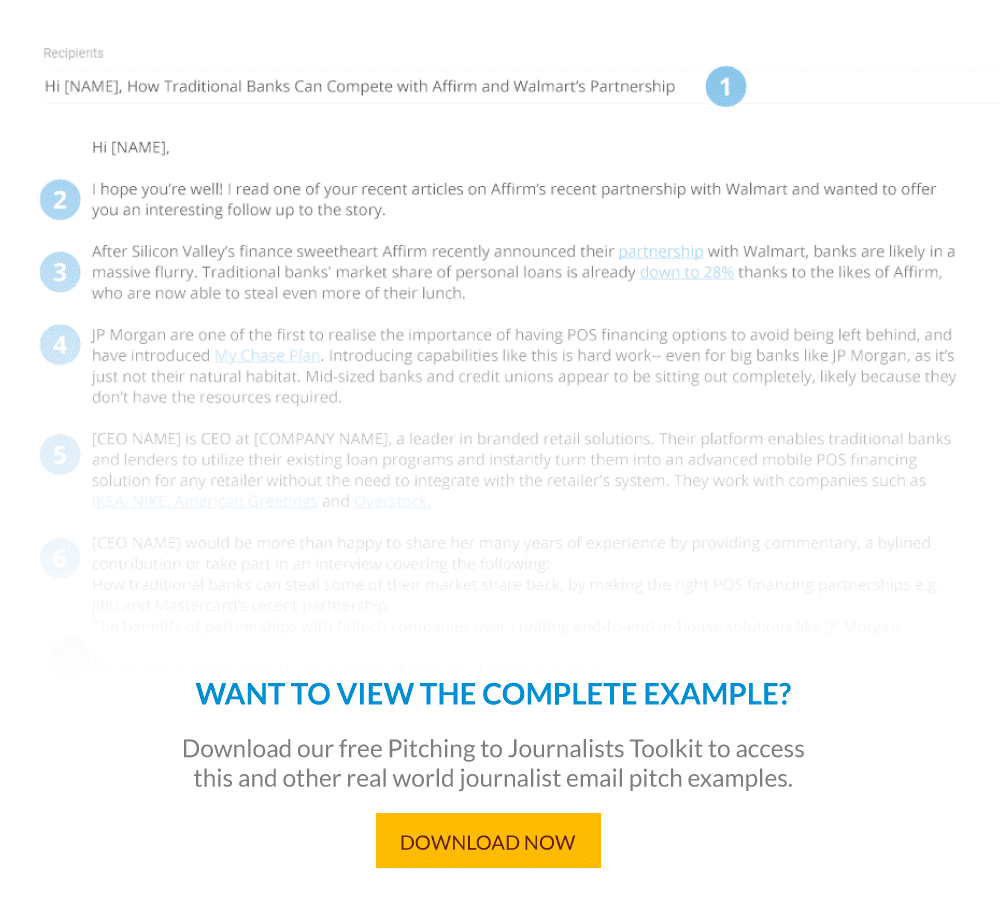
1. Subject
Use the subject line to grab the journalist’s attention. Call them out by name, then explain the subject crux of your pitch.
In this PR pitch example, we lead with the journalist’s name, then explain what the subject of the pitch is about – which in this case is a breaking news hook pitch.
2. Introduction & personalization
Use the first paragraph to provide the context of what it is you’re pitching and to personalize the pitch by relating it to something the journalist has recently written about.
It’s important that you know how to begin the pitch effectively and demonstrate that you are familiar with their work instead of being generic.
In this example, we start the pitch by referencing a recent article that the journalist wrote, which is on the topic of this breaking news hook pitch.
3. Context and angle
Use the next paragraph to start building your hook. Always support this with data points and links to other articles or research that supports your angle.
In this example, our angle is built around how traditional banks are feeling the pressure of fintechs and how this is eroding their market share. We also support this with a relevant data point.
4. Building out your angle
Use the following paragraph to fully flesh out your angle, if required.
In this example, the previous paragraph posed a problem, while this paragraph suggests a partial solution. This partial solution is then related to the “offer” at the end of the pitch.
5. Company/personal details and social proof
Now comes the introduction of the person offering the story and their company. Use this as your social proof, to explain why you’re qualified to talk about the subject you’re pitching.
In this example, as the offer is on behalf of a CEO at a fintech company, we’ve provided an explanation of what the company does, to demonstrate why the CEO is qualified to talk about this topic.
6. The actual offer
And here is the actual offer to the journalist. You need to explain exactly what it is you’re offering, which you can do here.
In this press pitch example, we’re offering a commentary, a bylined article (which is another term for a guest article) or an interview. We then provide details of the topics that this person can provide input on.
When’s the best time to send a pitch to journalist
Based on our own research, we find that the best time to contact a journalist is either Tuesday or Wednesday, between 8am and 9am.
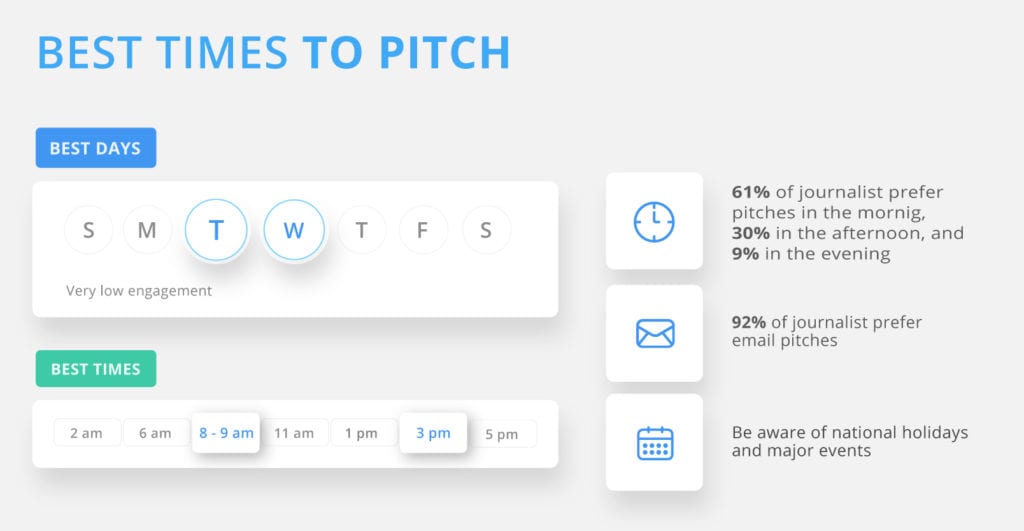
Pitching to journalists etiquette
When pitching to journalists, make sure you stay on their right side by following some basic etiquette.
- Make sure your pitch is relevant to the journalist’s beat. Journalists can understandably get very annoyed when they receive a pitch that’s completely irrelevant to them.
- If you’re pitching for a guest article spot, make sure the outlet actually accepts these submissions. Check their editorial policy or see if any recent articles are by guest authors.
- If you’re pitching for a guest article spot, send your pitch to an editor instead of a journalist. It’s an editor’s job to greenlight a guest article, not a journalist’s.
- Don’t contact two journalists working for the same publication at the same time. Although there’s no harm in pitching to a journalist at the same publication if a few weeks have passed since you pitched to the first journalist.
- If you’re offering your pitch as an exclusive, send it to journalists one at a time. State how long the offer stands for; this can be from 24 hours to a few days.
- Check Twitter handles to see if journalists are open to pitches. Some journalists will state on their Twitter handle that they’re open to pitches, while others will state that they’re not – don’t pitch to these journalists.
- Just send one PR pitch follow-up email. It’s fine to send a chaser to a journalist, a day or two after you emailed the pitch, but anything further won’t be appreciated. Keep it brief and don’t be pushy. Something along the lines of “I know you’re busy, so just touching base to see if you’ve had a chance to look at the below pitch or if you have any questions on this”.
Final Thoughts
Now that you’ve read our Guide on How to Pitch to Journalists, you know how to come up with pitch ideas, how to get press coverage, and how to contact the press the right way.
And we’ve made doing this even easier with our free Pitching to Journalists Toolkit. The toolkit provides everything you need to know on how to write a pitch and how to contact the press. It includes the best pitching tips and carefully selected email examples and tools such as:
- 6 real-world journalist email pitch examples
- Editable email pitch template Word doc
- Journalist pitch tracker Excel doc
With these pitching tips and PR tools, you will be able to get an article written about your company and get your name across prominent media outlets to boost your company’s growth.


